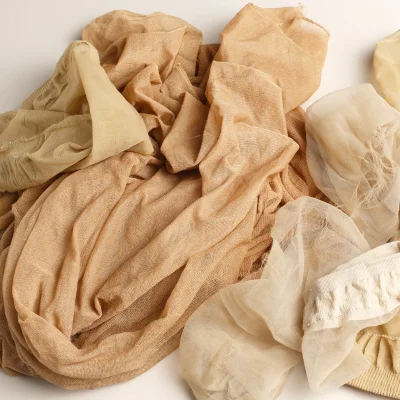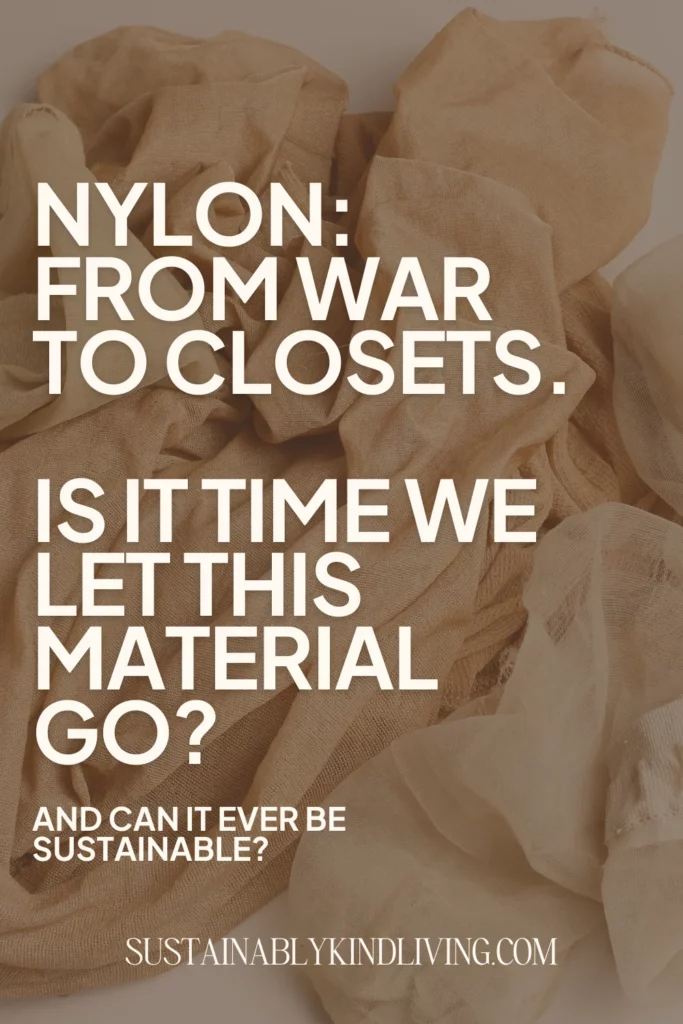SKL is reader supported. When you buy through links on our site, we may earn affiliate commission. Learn more here.
When you think of nylon, one of your first thoughts is likely related to stockings and hosiery. But nylon has varied applications and an interesting history.
It actually paved the way for the popular use of synthetic fabrics! Nylon is now one of the world’s most prevalent fabrics and materials. Given its popularity, it’s important to consider nylon’s environmental impact and if nylon is, infact, a good material.
This will be your guide to all things nylon— what it is, how it’s used, and whether it’s sustainable.

What is Nylon?
Nylon is the generic name for a family of synthetic polymers. You may also see it referred to as polyamide. It is a thermoplastic derived from petroleum that can be melted and processed to be formed into fibers, shapes, and films to create all sorts of consumer products, from clothing to car parts to food packaging.
Nylon’s History
Nylon originated in the DuPont chemical lab in the 1930s when company scientist W. H. Carothers created and patented nylon as the first fully synthetic polymer and fiber. It was first introduced commercially in toothbrushes!
Nylons’ debut in clothing was as nylon stockings in 1940 which were a major success. The stockings sold out within hours on the first day they were commercially available for sale. Nylon stockings made DuPont millions for the sale of the nylon yarn in the first few years on the market.
In 1942, the production of nylon was redirected to create parachutes, tents, and other supplies for the military during World War II. During this time, consumer demand for nylon continued to rise despite not being available.

Stockings were sold on the black market for a premium. After the war, demand still far exceeded the availability of nylon stockings. The scarcity resulted in the “nylon riots” in which women would compete and fight to get their hands on the limited number of stockings. At one such event, 40,000 women lined up for the sale of 13,000 stockings.
In the following years, nylon use continued to grow, and synthetic fabrics became more and more popular. Fabrics like nylon, polyester, rayon, and acrylic took the fashion industry by storm thanks to clever marketing, their durability, and cheaper production costs.
While nylon fabric isn’t nearly as popular as it used to be, it’s still commonly blended in with other fabrics. Nylon as a polymer is one of the most versatile materials, and we are surrounded by it in our daily lives, from the hair comb and dental products sitting in your bathroom to seatbelts and other car parts to your carpet and even your travel and camping gear.
The invention of nylon changed the world and is simply a part of our everyday lives at this point.
So, what is it, really??
What is Nylon made of?
Nylon is a synthetic polymer, meaning it’s a manmade chain of carbon-based molecules (monomers). There are many types of nylon, but it is commonly made up of diamine and adipic acid. Diamine is a product of crude oil extraction. Therefore, nylon is the result of a chemical reaction of a petroleum-based input.
How is Nylon made?
Nylon is an extremely versatile material, which is why we see it used in so many various products. As a thermoplastic, nylon becomes very workable when heated to extremely high temperatures yet firm once cooled. Condensation polymerization forms a large polymer—in the form of a sheet of nylon. To make nylon fabric for clothing/apparel, this nylon sheet is then broken into chips, melted, and drawn through a mechanical spinneret to produce individual fibres that are woven into fabric.
Properties of Nylon Materials:
Nylon was first advertised as an alternative to silk and supposedly more durable. In fact, it was initially marketed to be “as strong as steel,” but that slogan was quickly rolled back once they realized how misleading it was. While it is a sturdy material, it is still prone to runs, pilling, and other flaws.

As a plastic product, nylon is lightweight, strong, and abrasion resistant. It was used for the military, after all. Nylon is favored for being low-maintenance thanks to its wrinkle resistance, durability, and colorfastness. Here are some common questions about nylon clothing:
Is nylon stretchy?
Yes, nylon can have good stretch and elastic qualities, depending on the type. Generally, nylon holds its shape well and recovers well after being stretched. This also means that nylon pieces retain their shape well even after years of use. However, this trait may be compromised if it’s blended with weaker material.
Is nylon waterproof?
Kind of. It would be more accurate to say that nylon is water resistant or water repellant. While the plastic base of nylon makes the fiber waterproof, the fabric’s woven nature allows some water to slip through. Therefore, nylon will absorb some water but will still keep you relatively dry in light rain. To be made more waterproof, nylon can be treated with a coating, but that will reduce the fabric’s breathability and elasticity.
Does nylon shrink?
Nylon is unlikely to shrink on its own. When blended with other fabrics or exposed to high heat, shrinkage is possible. Yet, this shrinkage will still be lower than other fabrics like cotton.
Some of the nylon’s more undesirable traits include its inability to “wick moisture,” it can feel stuffy to the wearer, can cause static, and it will melt when exposed to too high of heat.
What is Nylon Used For?
When it comes to apparel, nylon is commonly used in tights, sportswear, fitted garments, and outdoor gear. Think: hosiery, tracksuits, and windbreakers.
Beyond clothing, you can find nylon as a textile in umbrellas, luggage, carpet, ropes, tents, and fishing nets (known for contributing to ocean pollution). Today, most of nylon’s applications exist outside of apparel.
These days, it’s uncommon to find nylon completely by itself in a textile. It is likely used in a fabric blend. Blends are created to optimize the functionality and feel of fabrics while mitigating the downsides of the individual textiles that make up the blend.
Nylon is often added to make garments more resilient, elastic, and lightweight, all while keeping costs down. It is added to Spandex to create swimwear and athletic wear. It is blended with cotton to make fabrics more durable while still retaining softness and breathability. Nylon is also combined with wool to make the material stronger and softer while allowing for wool’s functionality and warmth in outdoor apparel.
Is Nylon Sustainable?
Nylon undoubtedly deserves its place in history books for how it has changed the trajectory of fashion and many other manufactured goods. But does it deserve a place in fashion now, given its petrochemical production roots?
In order to determine if nylon, or any fabric, is bad for the environment, there are several factors to consider:
- The raw material of the fabric and how it’s sourced
- The processing, i.e., how is it made into a fabric
- It’s quality
- Its end-of-life prospects
Let’s explore how sustainable nylon is within these lifecycle stages:
Raw Material:
Nylon’s primary component, diamine, is made from fossil fuels. We know that the extraction and use of fossil fuels are harmful to the environment as nonrenewable resources. Nylon’s second component, adipic acid, releases nitrous oxide in its production. One pound of nitrous oxide (also known as laughing gas) warms the atmosphere 300 times more than a pound of carbon over a 100-year period. While nitrous oxide isn’t as prevalent as carbon dioxide, it’s more potent and still a huge threat to the ozone layer.

Production:
Beyond the petroleum and nitrous oxide problems, the production of nylon takes a lot of energy and water. First, the chemical reactions and melting processes that create nylon require high heat. Then, the water used to produce, treat, and dye nylon carries toxic pollutants into the surrounding environment of the manufacturing facilities.
Quality:
Despite being known for its durability, nylon doesn’t have a reputation associated with high quality. In fact, it’s quite the opposite. Nylon mostly exists in blends because it’s not a great material by itself. While it can make fabrics stronger and give them a longer life, this is only a positive trait for a petroleum-based material if it reduces consumer demand and new production.
However, how fashion is produced and consumed (especially by brands using nylon) focuses on planned obsolescence and trend turnover. So the durability isn’t being taken advantage of and then becomes a problem in the landfills.
Additionally, nylon is a major culprit for microfibers and microplastic pollution. Every time we wear and wash our nylon pieces, they shed tiny microplastics that inevitably find their way into our waterways and food chain. Just washing synthetic fabrics like polyester, nylon, or acrylic accounts for around half a million tonnes of plastic microfibers are released into the ocean every year.
End-of-Life:
Fossil fuel-based products or plastics (which nylon is) can take a long time to decompose in landfill. And unfortunately, landfill is where most clothing ends up.
Commonly Asked Questions About Nylon
Is nylon biodegradable?
No. Nylon is a synthetic material that can’t biodegrade. Nylons can take decades to even centuries to fully break down.
Is nylon recyclable?
Textile recycling technology and infrastructure does not exist to be able to properly recycle nylon fabrics at scale. While there are some facilities that can recycle nylon, they aren’t common or easily accessible. The most likely place you could recycle nylon would be through a take-back program. Recycling nylon is further complicated by most of the nylon being used in blends. Fabric blends are virtually impossible to recycle. Therefore, when you see something labeled “recycled nylon,” the initial nylon that was recycled is most likely to be fishing nets or carpeting, not nylon apparel.
Therefore, the most sustainable end-of-life prospect for nylon clothing is to keep them in use for as long as possible to avoid the inevitable trip to landfill.
Given nylon’s ties to fossil fuels, harmful production processes, plastic pollution, and grim disposal prospects, nylon cannot be considered to be a sustainable material. It’s best avoided when it comes to new purchases. When it comes to nylon you already own, the most eco-friendly route is wearing your nylon pieces as long as possible and then finding ways to repurpose and upcycle them.
Are There Sustainable Alternatives to Nylon?
So, if nylon isn’t sustainable, are there alternatives or better versions of nylon? The most common, more sustainable version of nylon is recycled nylon.
Recycled Nylon
Recycled nylon is often created with ocean waste, such as nylon fishing nets. Given the pervasiveness of ocean plastics, it’s great to have a solution that diverts the waste of fishing nets and makes them functional again. It also reduces the need for new fossil fuel extraction.
While recycled nylon still relies on a fossil fuel input, it can offer the same quality as new nylon without the initial extraction and harm.
“Econyl”
You may recognize recycled nylon under the name of Econyl. Econyl uses a chemical recycling process that depolymerizes the collected nylon from fishing nets, carpets, and fabric scraps and uses the raw material distilled from the process to create the “new” nylon products.
This type of recycling is rare within textile recycling and actually allows for increased circularity. Econyl claims that its materials are 100% regenerated and infinitely regenerable, which would mean this process could be repeated over and over again. Econyl offers a great alternative to nylon. While natural fibers may still be more ideal, the industry will unlikely completely move away from synthetics or semi-synthetics due to their function. So, Econyl offers an option that can function like nylon without the massive harm that comes from that initial fossil fuel extraction process.
While it may be a “more sustainable” option, it’s important to note that it still has some drawbacks. Recycled nylon is still not biodegradable and will still release microplastics. Its reliance on fossil fuels means it’s more of an interim solution than a long-term one. The true sustainability of this material lies in whether recycled nylon can make it back to the facilities to be recycled again and again. If the systems don’t exist to make this recycling possible, recycled nylon will be sitting next to nylon in the landfill.
You can see a full list of brands using Econyl here or see below for our top picks!
Trusted Brands using Recycled Nylon or “Econyl”
Girlfriend Collective
Girlfriend Collective is not only one of the most size-inclusive destinations for organic cotton sweatpants & eco hoodies with sizes up to 6XL, but also a great place to recycle old clothes that cannot be donated.
They use Premium Sustainable & Recycled Materials that are Sa8000 Fair Trade Certified for their comfy, casually cool basics. Seriously, you can find EVERYTHING from affordable sustainable swimwear and bras to eco-friendly maternity clothes –all perfectly fitted, curve-hugging, and utterly smooth.
Size Range: 2XS – 6XL
Price Range: $15+
Location/Shipping: USA, ships to Canada, UK, and Australia
Swedish Stockings
Swedish Stockings is a European-based circular hosiery brand and one of the most sustainable brands for tights worldwide.
On top of working to divert waste materials from landfills by using pre/post-consumer materials, they also launched their own Swedish Stockings Recycling Club in 2016 that turns used tights into filler material for new products!
Their buttery-soft fabrics of choice? OEKO-TEX Standard 100 certified and Bluesign certified recycled polyamide, recycled polyester, organic and recycled cotton, organic wool, and cashmere.
Size Range: S-XL
Price Range: $7+
Location/Shipping: Sweden, worldwide shipping is available
Outerknown
Outerknown’s extensive line of recycled bathing suits runs the gamut from tropical-inspired reversible sustainable swimwear to one-of-a-kind vintage styles made from ECONYL in California.
Part of the profit goes to ocean conservation programs like the Ocean Conservancy.
Size Range: XS to 2XL
Price: from $68
Location/Shipping: Sold from the USA | Worldwide Shipping
Ohoy Swim
OHOY swimwear creates pieces that focus on Scandinavian simplicity and high quality. Made ethically in a family-owned factory in Portugal, OHOY Swim prioritizes responsible practices and better materials. 1% of sales go to efforts to rid the seas of nets.
Size Range: S-XL
Price Range: $30+
Location/Shipping: Ships from Estonia | Worldwide Shipping
This was the full guide to Nylon!
While nylon isn’t sustainable, there are some interesting innovations that offer better options. The materials industry has been changing rapidly over the past couple years, which is a good reason to have hope that better solutions are on their way! In the meantime, take care of what you have!
If you liked this blog post on Nylon, learn more with these other blogs from our SKL team:


 Enter To Win Over $1500+ In Non-Toxic Goodies!
Enter To Win Over $1500+ In Non-Toxic Goodies! 











